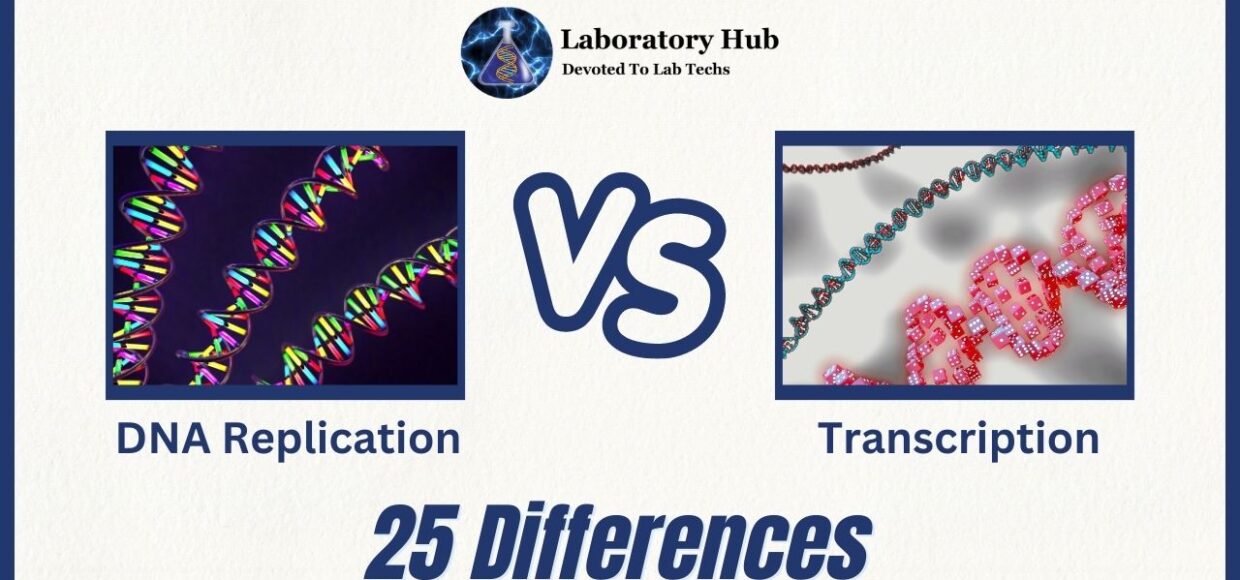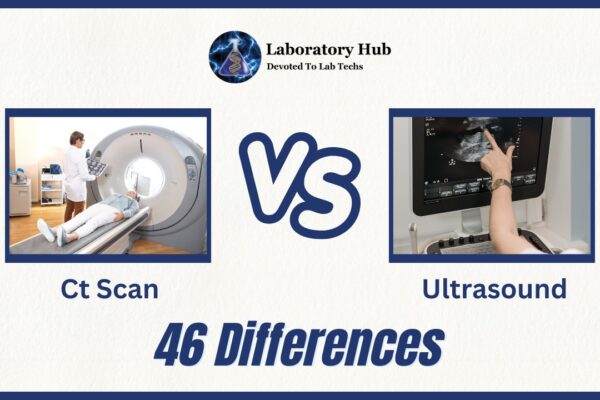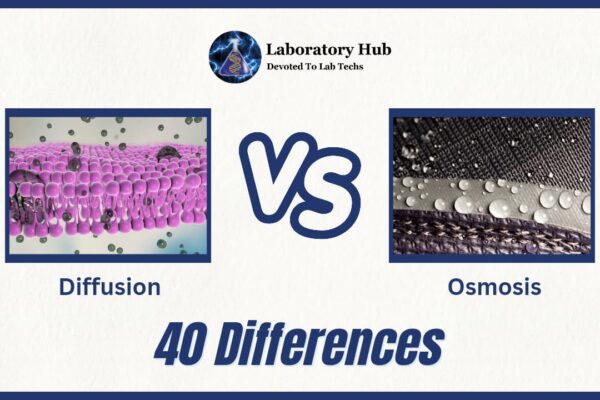DNA Replication vs Transcription- 25 Differences
Introduction
DNA replication and transcription are essential molecular biology processes for living organisms. Both use DNA’s genetic information. DNA replication and transcription differ in aim, process, and consequence. Understanding these differences is crucial to understanding genetics and gene expression.
A cell replicates its genome to pass on genetic information. Growth, development, and genetic stability depend on it throughout the cell cycle’s synthesis (S) phase. Semi-conservative replication produces DNA molecules with one original strand and one freshly synthesized strand. DNA polymerases unwind the DNA double helix and synthesize complementary nucleotide strands.
Transcription synthesizes RNA from a DNA template. It helps DNA make functional RNA molecules like mRNA, tRNA, and rRNA during gene expression. Eukaryotic cells’ nuclei initiate, elongate, and terminate transcription. RNA polymerase attaches to the promoter, unwinding DNA and synthesizing RNA with complementary nucleotides. Termination ends transcription, whereas elongation extends RNA.
DNA replication and transcription synthesize nucleic acids for different reasons. DNA replication preserves genetic information, whereas transcription transfers it to functional RNA molecules. DNA replication duplicates a DNA molecule, while transcription synthesizes RNA from a DNA template. DNA replication occurs in the nucleus during the S phase of the cell cycle, whereas transcription occurs in the nucleus during interphase.
DNA replication and transcription are essential molecular biology activities. DNA replication and transcription synthesize RNA molecules to accurately transmit genetic information. Understanding the similarities and variations between these processes is essential to understanding genetics and gene expression in living organisms.
READ ALSO: O antigen vs H antigen – 25 Differences
S.No. | Category | DNA Replication | Transcription |
1 | Definition | The process of synthesizing an identical copy of a DNA molecule. | The process of synthesizing an RNA molecule from a DNA template. |
2 | Enzyme | DNA polymerase is the main enzyme involved in DNA replication. | RNA polymerase is the main enzyme involved in transcription. |
3 | Template Strand | Both DNA strands are used as templates for replication. | Only one of the DNA strands (the template strand) is used for transcription. |
4 | Product | The end product of DNA replication is two identical DNA molecules. | The end product of transcription is an RNA molecule. |
5 | Location | DNA replication occurs in the nucleus in eukaryotes and the cytoplasm in prokaryotes. | Transcription occurs in the nucleus in eukaryotes and the cytoplasm in prokaryotes (mRNA). |
6 | Initiation | DNA replication starts at specific sites called origins of replication. | Transcription starts at specific sites called promoters. |
7 | Primer Requirement | DNA replication requires a primer to initiate synthesis. | Transcription does not require a primer. |
8 | Nucleotide Triphosphates | DNA replication utilizes deoxyribonucleotide triphosphates (dNTPs). | Transcription utilizes ribonucleotide triphosphates (NTPs). |
9 | Base Pairing | DNA replication follows the base pairing rule (A-T and G-C). | Transcription follows the base pairing rule (A-U and G-C). |
10 | Proofreading | DNA replication includes a proofreading mechanism by DNA polymerase. | Transcription lacks proofreading and error-checking mechanisms. |
11 | Termination | DNA replication has specific termination sequences or mechanisms. | Transcription has termination signals that lead to the release of the RNA transcript. |
12 | Enzyme Processivity | DNA replication enzymes are highly processive, remaining associated with the DNA template for long stretches. | RNA polymerase is less processive and dissociates from the DNA template after transcription. |
13 | Complementary Strand Synthesis | DNA replication synthesizes a complementary strand to the template strand. | Transcription synthesizes an RNA molecule that is complementary to the template DNA strand. |
14 | Leading and Lagging Strand | DNA replication involves the synthesis of both leading and lagging strands. | Transcription involves the synthesis of a single RNA molecule. |
15 | RNA Processing | DNA replication does not involve RNA processing. | Transcription undergoes RNA processing, including capping, splicing, and polyadenylation. |
16 | RNA Stability | RNA molecules are generally less stable and have a shorter lifespan. | DNA molecules are more stable and have a longer lifespan. |
17 | Gene Expression | DNA replication does not directly contribute to gene expression. | Transcription is a key step in gene expression, providing the template for protein synthesis. |
18 | Template Usage | DNA replication uses both strands of the DNA duplex as templates. | Transcription uses one strand (template strand) to synthesize RNA. |
19 | Promoter Recognition | DNA replication does not involve promoter recognition. | Transcription requires the recognition of specific promoter sequences by RNA polymerase. |
20 | Process Complexity | DNA replication is a highly complex process involving multiple proteins and steps. | Transcription is relatively simpler compared to DNA replication. |
21 | Fidelity | DNA replication has a high fidelity with a low error rate. | Transcription has a higher error rate and may introduce occasional mutations. |
22 | Mutagenic Effects | Errors in DNA replication can lead to permanent changes in the DNA sequence and potential mutations. | Errors in transcription do not directly affect the DNA sequence but can affect protein synthesis. |
23 | Role in Protein Synthesis | DNA replication is not directly involved in protein synthesis. | Transcription produces RNA molecules that serve as templates for protein synthesis. |
24 | Regulation | DNA replication is tightly regulated and occurs during the S phase of the cell cycle. | Transcription is regulated by various factors and can be influenced by environmental cues. |
25 | Overall Purpose | DNA replication ensures the faithful transmission of genetic information during cell division. | Transcription is involved in the synthesis of RNA molecules for various cellular processes. |
Frequently Asked Questions (FAQs)
DNA replication ensures genetic continuity during cell division. Using a DNA template, transcription synthesizes RNA molecules to express genes. Both processes synthesize nucleic acids, but their goals and methods differ.
DNA replication safeguards genetic information in numerous ways. DNA polymerases proofread nucleotide incorporation mistakes. Since DNA polymerase can only add complementary nucleotides to the developing DNA strand, complementary base pairing promotes proper replication.
RNA polymerase synthesizes RNA during transcription. It unwinds DNA by binding to the promoter. Using the DNA template, it adds complementary RNA nucleotides to the developing RNA strand. RNA polymerase controls transcription initiation, elongation, and termination.
Transcription and replication are tightly controlled. DNA replication is initiated only once each cell cycle by regulatory proteins at particular locations. Transcription factors affect gene expression by interacting with enhancers and repressors. DNA methylation and histone changes regulate transcription.
DNA replication and transcription can have mistakes. Mutations can result from DNA damage, environmental causes, or enzyme errors. Mutations can cause genetic differences and disorders, even though DNA replication and transcription are usually accurate. However, correction processes reduce these faults.







